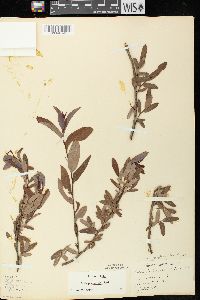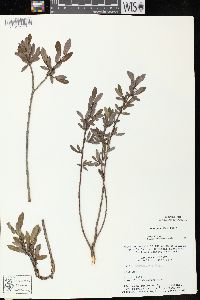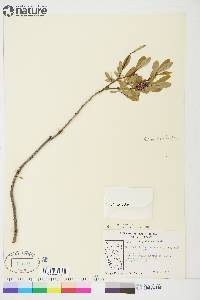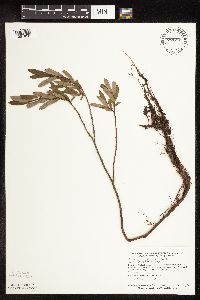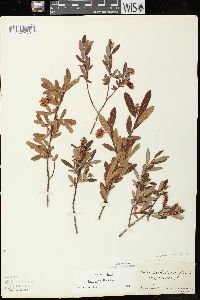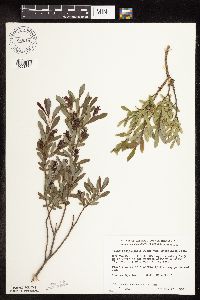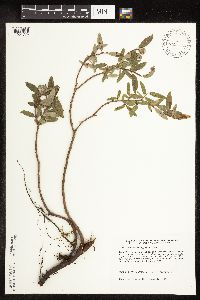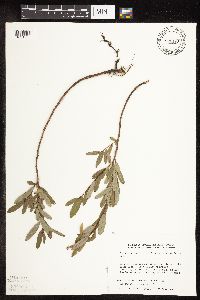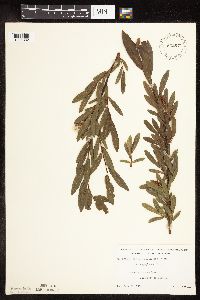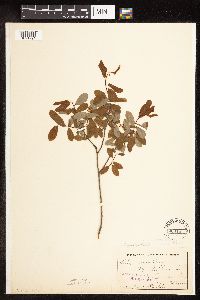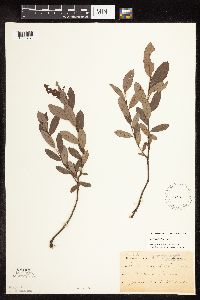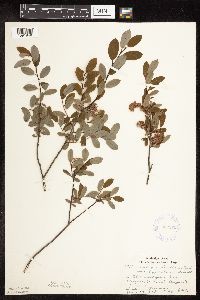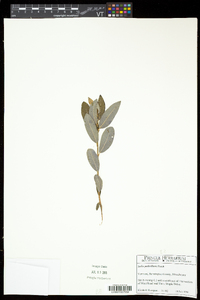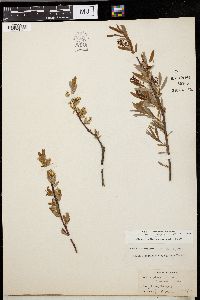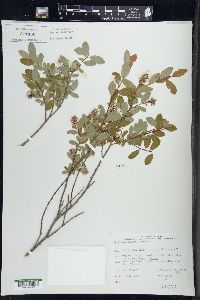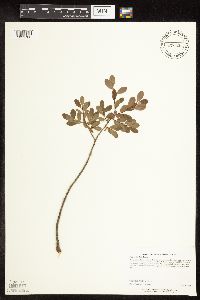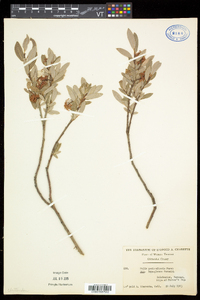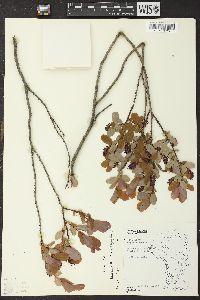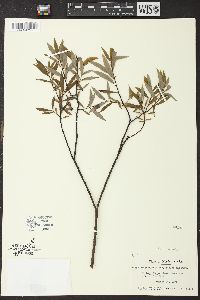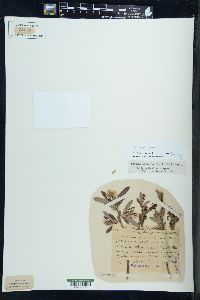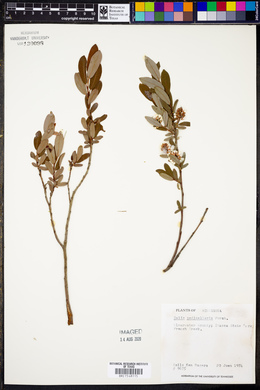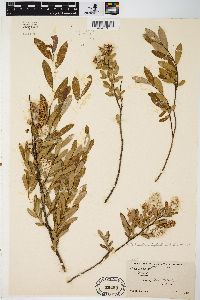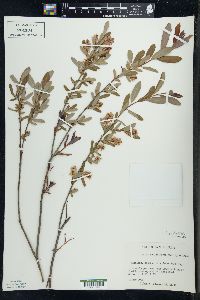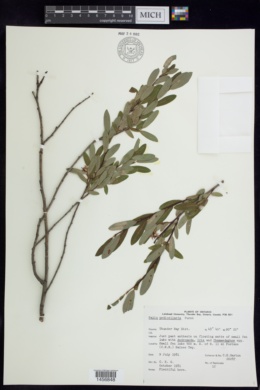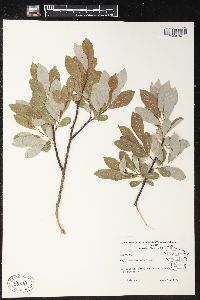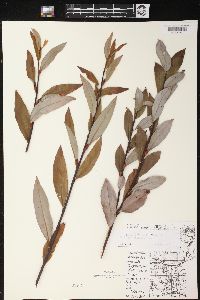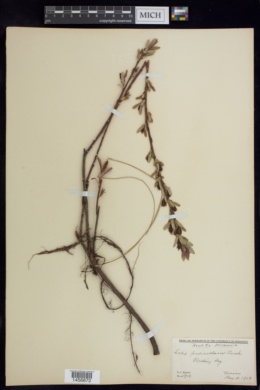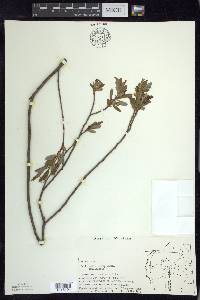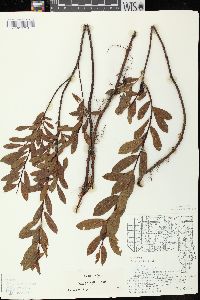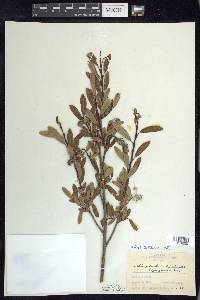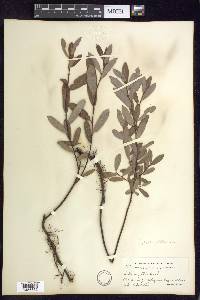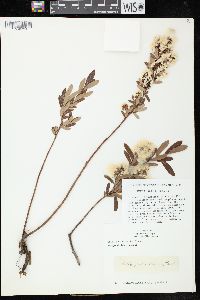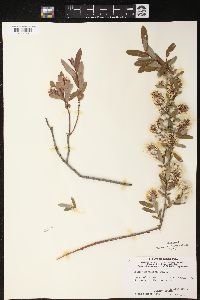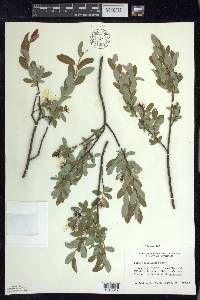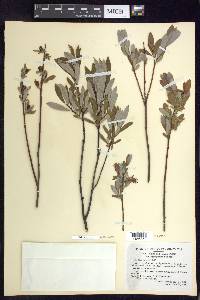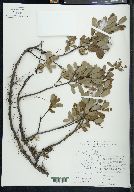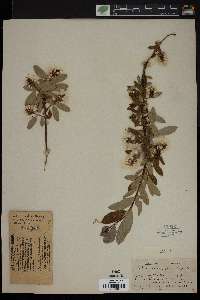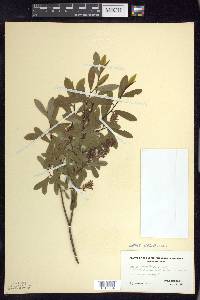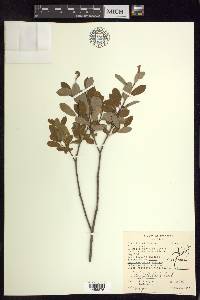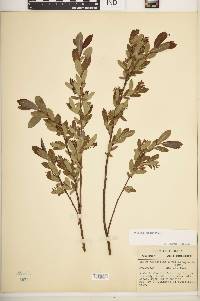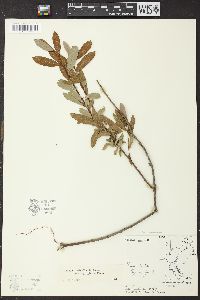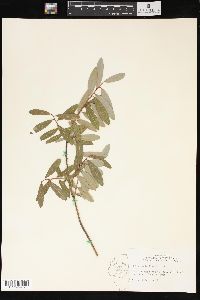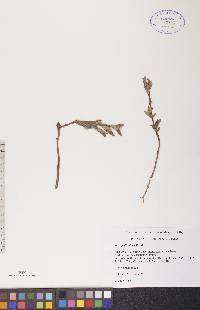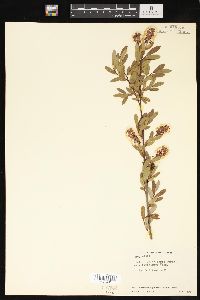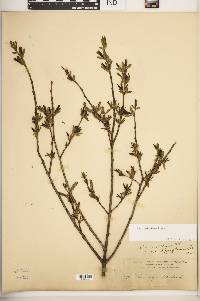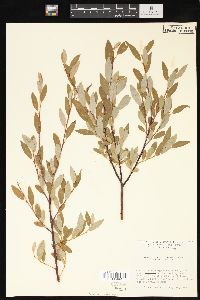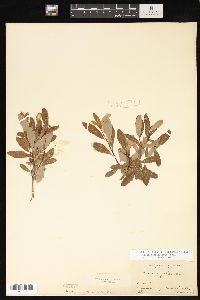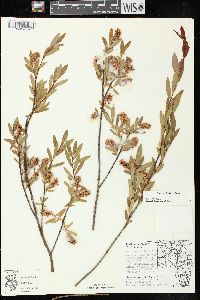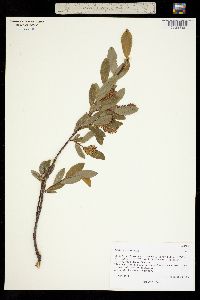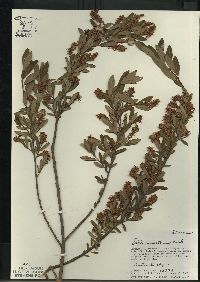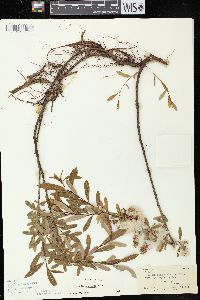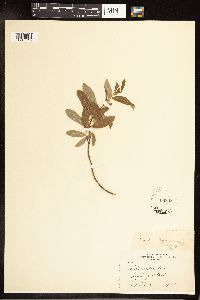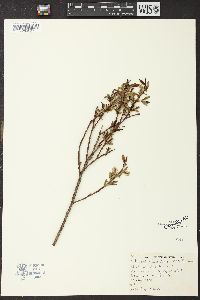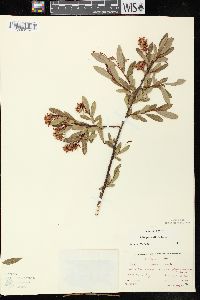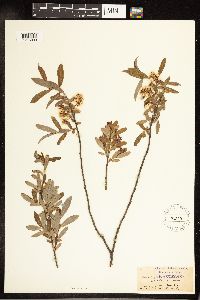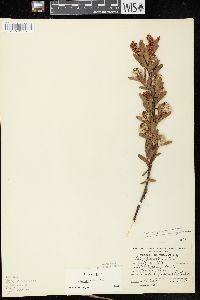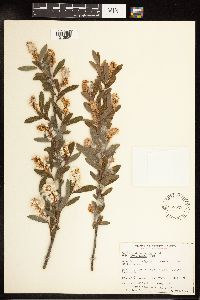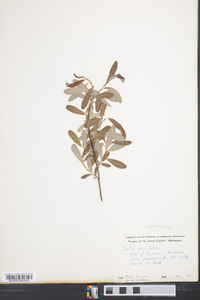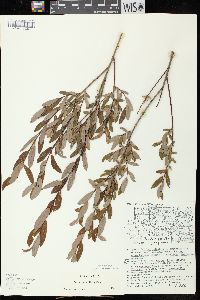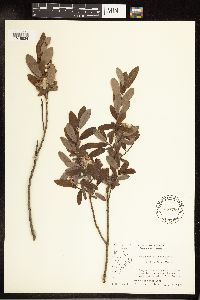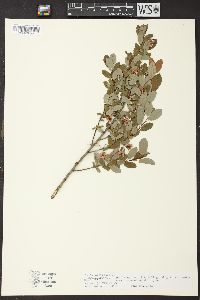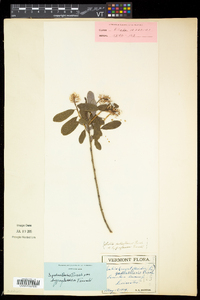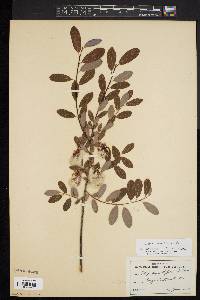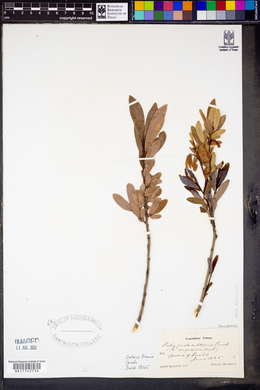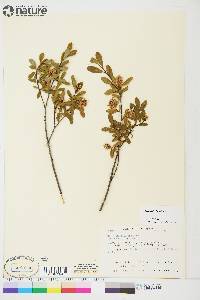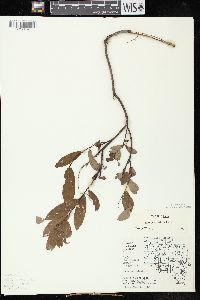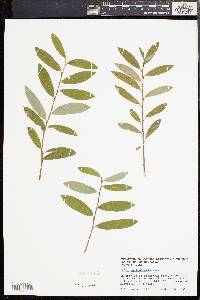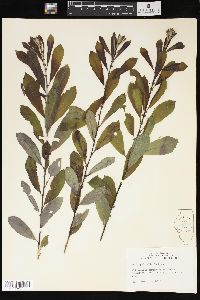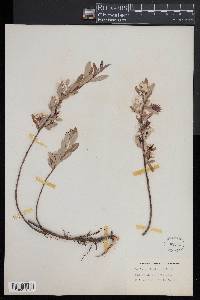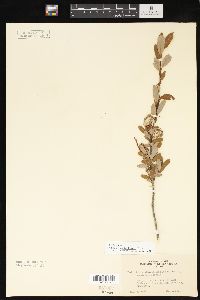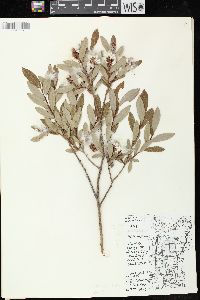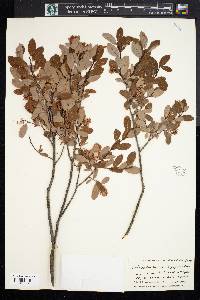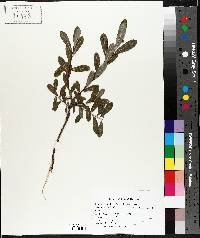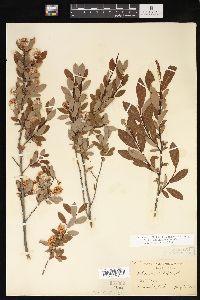
|
|
|
|
Family: Salicaceae
Bog Willow
|
Plants 0.2-1.5 m, forming clones by layering. Stems erect, decumbent or trailing; branches gray-brown, glabrous; branchlets yellow-brown or red-yellow, glabrous or puberulent (hairs straight, minute, inner membranaceous bud-scale layer free, not separating from outer layer). Leaves: stipules absent or rudimentary; petiole (deeply to shallowly grooved adaxially), 3-8 mm, (glabrous or puberulent); largest medial blade narrowly oblong, oblong, narrowly to broadly elliptic, narrowly oblanceolate or oblanceolate, 19-53(-69) × 5-20 mm, 1.8-4.9 times as long as wide, base convex or rounded, margins flat or slightly revolute, entire, apex acute, convex, or rounded, abaxial surface glabrous, adaxial dull, glaucous, glabrous (rarely very sparsely short-silky, hairs usually white, sometimes also ferruginous); proximal blade margins entire; juvenile blade (reddish or yellowish green), glabrous, puberulent, or sparsely pubescent abaxially, (hairs usually white, sometimes also ferruginous). Catkins: staminate 11-21 × 4-8 mm, flowering branchlet 3-12 mm; pistillate loosely flowered, stout or subglobose, 14-37 × 5-14 mm, flowering branchlet 7-25 mm; floral bract tawny or light rose, 0.8-1.6 mm, apex rounded, entire, abaxially very sparsely hairy distally, hairs straight or wavy. Staminate flowers: abaxial nectary absent, adaxial nectary oblong or narrowly oblong, 0.5-1.1 mm; filaments distinct or connate less than 1/2 their lengths, glabrous, or hairy basally or on proximal 1/2; anthers (yellow), ellipsoid, 0.4-0.6 mm. Pistillate flowers: abaxial nectary absent, adaxial nectary oblong, 0.2-1.4 mm, shorter than stipe; stipe 2.1-3.2 mm; ovary obclavate, often glaucous, glabrous, beak abruptly tapering to styles; ovules 4-6 per ovary; styles connate or distinct 1/2 their lengths, 0.1-0.2 mm; stigmas flat, abaxially non-papillate with rounded tip, or 2 plump lobes, 0.2-0.25-0.36 mm. Capsules 4-8 mm. 2n = 38, 57, 76. Flowering mid Apr-mid Jul. Sphagnum bogs, fens, black spruce treed bogs; 0-1400 m; St. Pierre and Miquelon; Alta., B.C., Man., N.B., Nfld. and Labr., N.S., Nunavut, Ont., Que., Sask., Yukon; Conn., Idaho, Ill., Ind., Iowa, Maine, Mass., Mich., Minn., N.H., N.J., N.Y., N.Dak., Ohio, Oreg., Pa., R.I., Vt., Wash., Wis. Salix pedicellaris is found in Nunavut on Akimiski Island in James Bay and on the Belcher Islands in Hudson Bay. Salix pedicellaris is very distinct with decumbent habit, leathery, glabrous leaves that are glaucous on both surfaces, loosely flowered catkins, ovaries reddish, glabrous and often glaucous, and stipes 2.1-3.2 mm. In the flora area, it hybridizes with six other species (see below). This compares with the closely related European S. myrtilloides Linnaeus, which is reported (B. Jonsell and T. Karlsson 2000+, vol. 1) to hybridize with seven species. The distinctive appearance may make hybrids easily recognizable but it is complex cytologically. Hybrids: Salix pedicellaris forms natural hybrids with S. arctica, S. argyrocarpa, S. athabascensis, S. chlorolepis, S. glauca var. cordifolia, S. pedicellaris, and S. pellita. Hybrids with S. candida and S. eriocephala have been reported (M. L. Fernald 1950) but no convincing specimens have been seen. Salix pedicellaris × S. pellita (S. ×jamesensis Lepage) was described from the west coast of James Bay, Ontario. It is to be expected throughout northern Ontario and Quebec. According to E. Lepage (1964), its yellowish midveins and the hairiness of floral bracts superficially resemble those of S. pellita forma psila C. K. Schneider (syn. S. pellita forma denudata), but its reticulate leaf venation resembles that of S. pedicellaris.
Shrub to 1.5 m tall Leaves: alternate, lacking stipules, on 2 - 7 mm long leafstalks, green above, whitish with a waxy coating (glaucous) beneath, 2 - 8 cm long, 0.5 - 3 cm wide, elliptic to lance-shaped to egg-shaped with a tapering base and blunt to pointed tip, slightly revolute (rolled downward along the margins), and finely net-veined on both sides (raised) with parallel primary lateral veins. At first the leaf is silky-hairy, but it becomes hairless. Flowers: either male or female, borne on separate trees (dioecious) in cylindrical catkins. The catkin is hairy and grows on a short, leafy stalk. Female catkin greenish or reddish with yellowish brown scales, to 3 cm long. Male catkin 1 - 2 cm long, with yellowish brown scales. Stamens two. Fruit: a capsule, in crowded, elongated clusters, stalked, brownish, 4 - 7 mm long, and flask-shaped. Seeds have long, white, silky hairs attached. Twigs: yellowish to light brown or reddish brown. Buds: reddish brown, conical, pointed, flattened, and appressed to the stem. Form: slender with sparse, ascending branches. Similar species: In the Chicago Region, Salix pedicellaris differs from most other willows by having hairless, revolute leaves that are not distinctly toothed. The leaves of Salix humilis var. humilis and S. humilis var. tristis are similar to those of S. pedicellaris, but they are not finely net-veined on both sides; nor are the primary lateral veins parallel. Flowering: April to May, with the leaves Habitat and ecology: Local in bogs. Also grows in fens. Occurence in the Chicago region: native Etymology: Salix is the Latin word for willow. Author: The Morton Arboretum Slender, sparingly branched shrub (2-)4-10(-15) dm, with dark, glabrous twigs; stipules none; petioles short, mostly 2-7 mm; lf-blades at first silky, but very soon glabrous, entire, narrowly or broadly elliptic to oblanceolate or obovate, (2-)3.5-6(-8) נ0.5-2(-3) cm, entire, often slightly revolute, green above, commonly glabrous and glaucous beneath, finely raised-reticulate on both sides, with parallel primary lateral veins; catkins with the lvs, 1-3 cm, on leafy peduncles 2-4(-5) cm; scales 1 mm, yellowish-brown, hairy within, at least near the tip, the hairs surpassing the scale, otherwise generally glabrous; stamens 2; frs narrowly lanceolate, 4-7 mm; pedicels 2-3 mm; style 0.1-0.3 mm; 2n=38, 57, 76. Sphagnum-bogs and swamps; Nf. to Yukon and B.C., s. to N.Y., N.J., n. Io., and Oreg. Gleason, Henry A. & Cronquist, Arthur J. 1991. Manual of vascular plants of northeastern United States and adjacent Canada. lxxv + 910 pp. ©The New York Botanical Garden. All rights reserved. Used by permission. From Flora of Indiana (1940) by Charles C. Deam Infrequent in the lake area with an outlying post in the Elliott's Mill Bog in Wayne County. It is a small bog willow and usually found in sphagnum in tamarack bogs. …… Indiana Coefficient of Conservatism: C = 10 Wetland Indicator Status: OBL |


